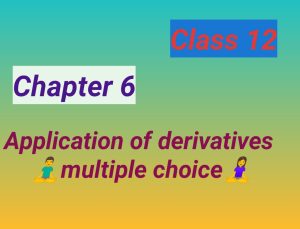EXERCISE 6.1
1. Find the rate of change of the area of a circle with respect to its radius r when. (class 12 maths ex 6.1 ncert solution)
(a) r = 3 cm (b) r = 4 cm.
Solution: We know that the area of a circle, ![]()
Therefore, the rate of change of the area with respect to its radius is given by
![]()
![]()
(a) When ![]()
Then,
![]()
![]()
Thus, the area is changing at the rate of ![]() .
.
(b) When ![]()
Then,
![]()
![]()
Thus, the area is changing at the rate of ![]() .
.
Question 2: The volume of a cube is increasing at the rate of ![]() . How fast is the surface area increasing when the length of its edge is
. How fast is the surface area increasing when the length of its edge is ![]() ?
?
Solution: Let the side length, volume and surface area respectively be equal to ![]() and
and ![]() .
.
Hence, ![]() and
and ![]()
We have,
![]()
Therefore,
![]()
![]()
![]()
![]()
Now,
![]()
![]()
![]()
![]()
![]()
So, when ![]()
Then,
![]()
![]()
Question 3: The radius of a circle is increasing uniformly at the rate of ![]() . Find the rate at which the area of the circle is increasing when the radius is
. Find the rate at which the area of the circle is increasing when the radius is ![]() .
.
Solution: We know that ![]()
Now,
![]()
![]()
We have,
![]()
Hence,
![]()
![]()
So, when ![]()
Then,
![]()
![]()
Question 4: An edge of a variable cube is increasing at the rate of ![]() . How fast is the volume of the cube increasing when the edge is
. How fast is the volume of the cube increasing when the edge is ![]() long?
long?
Solution: Let the length and the volume of the cube respectively be ![]() and
and ![]() .
.
Hence, ![]()
Now,
![]()
![]()
![]()
We have,
![]()
Hence,
![]()
![]()
So, when ![]()
Then,
![]()
![]()
Question 5: A stone is dropped into a quiet lake and waves move in circles at the speed of ![]() . At the instant when the radius of the circular wave is
. At the instant when the radius of the circular wave is ![]() , how fast is the encoding area is increasing?
, how fast is the encoding area is increasing?
Solution: We know that ![]()
Now,
![]()
![]()
We have,
![]()
Hence,
![]()
![]()
So, when ![]()
Then,
![]()
![]()
Question 6: The radius of a circle is increasing at the rate of ![]() . What is the rate of increase of its circumference?
. What is the rate of increase of its circumference?
Solution: We know that ![]()
Now,
![]()
![]()
![]()
We have,
![]()
Hence,
![]()
![]()
Question 7: The length ![]() of a rectangle is decreasing at the rate of
of a rectangle is decreasing at the rate of ![]() minute and the width
minute and the width ![]() is increasing at the rate of
is increasing at the rate of ![]() minute. When
minute. When ![]() and
and ![]() , find the rate of change of (a) the perimeter and (b) the area of the rectangle.
, find the rate of change of (a) the perimeter and (b) the area of the rectangle.
Solution: It is given that ![]() minute,
minute,![]() minute,
minute,![]() and
and ![]()
(a) The perimeter of a rectangle is given by ![]()
Therefore,
![]()
![]()
![]()
![]()
![]()
![]()
(b) The area of a rectangle is given by ![]() Therefore,
Therefore,
![]()
![]()
![]()
![]()
When ![]() and
and ![]()
Then,
![]()
![]()
Question 8: A balloon, which always remains spherical on inflation, is being inflated by pumping in 900 cubic centimeters of gas per second. Find the rate at which the radius of the balloon increases when the radius is ![]() .
.
Solution: We know that ![]()
Hence,
![]()
![]()
![]()
We have,
![]()
Therefore,
![]()
![]()
![]()
When radius, ![]()
Then,
![]()
![]()
Question 9: A balloon, which always remains spherical has a variable radius. Find the rate at which its volume is increasing with the radius when the latter is ![]() .
.
Solution: We know that ![]()
Therefore,
![]()
![]()
![]()
When radius, ![]()
Then,
![]()
![]()
Thus, the volume of the balloon is increasing at the rate of ![]() .
.
Question 10: A ladder is ![]() long is leaning against the wall. The bottom of the ladder is pulled along the ground, away from the wall, at the rate of
long is leaning against the wall. The bottom of the ladder is pulled along the ground, away from the wall, at the rate of ![]() . How fast is its height on the wall decreasing when the foot of the ladder is
. How fast is its height on the wall decreasing when the foot of the ladder is ![]() away from the wall?
away from the wall?
Solution: Let the height of the wall at which the ladder is touching it be ![]() and the distance of its foot from the wall on the ground be
and the distance of its foot from the wall on the ground be ![]() .
.
Hence,
![]()
![]()
![]()
Therefore,
![]()
![]()
![]()
We have,
![]()
Thus,
![]()
When ![]()
Then,
![]()
![]()
Question 11: A particle is moving along the curve ![]() . Find the points on the curve at which the
. Find the points on the curve at which the ![]() coordinate is changing 8 times as fast as the
coordinate is changing 8 times as fast as the ![]() -coordinate.
-coordinate.
Solution: The equation of the curve is ![]()
Differentiating with respect to time, we have
![]()
![]()
According to the question, ![]() Hence,
Hence,
![]()
![]()
![]()
![]()
![]()
When ![]()
Then,
![]()
![]()
![]()
When ![]()
Then,
![]()
![]()
![]()
Thus, the points on the curve are ![]() and
and ![]() .
.
Question 12: The radius of an air bubble is increasing at the rate of ![]() . At which rate is the volume of the bubble increasing when the radius is
. At which rate is the volume of the bubble increasing when the radius is ![]() ?
?
Solution: Assuming that the air bubble is a sphere, ![]() Therefore,
Therefore,
![]()
![]()
We have,
![]()
When ![]()
Then,
![]()
![]()
Question 13: A balloon, which always remains spherical, has a variable diameter ![]() . Find the rate of change of its volume with respect to
. Find the rate of change of its volume with respect to ![]() .
.
Solution: We know that ![]()
It is given that diameter, ![]()
Hence, ![]()
Therefore,
![]()
![]()
Thus,
![]()
![]()
Question 14: Sand is pouring from a pipe at the rate of ![]() . The falling sand forms a cone on the ground in such a way that the height of the cone is always one-sixth of the radius of the base. How fast is the height of the sand cone increasing when height is
. The falling sand forms a cone on the ground in such a way that the height of the cone is always one-sixth of the radius of the base. How fast is the height of the sand cone increasing when height is ![]() ?
?
Solution: We know that ![]()
It is given that, ![]()
Hence, ![]()
Therefore,
![]()
![]()
Thus,
![]()
![]()
![]()
We have,
![]()
When ![]()
Then,
![]()
![]()
![]()
Question 15: The total cost ![]() in Rupees associated with the production of
in Rupees associated with the production of ![]() units of an item is given by
units of an item is given by ![]() . Find the marginal cost when 17 units are produced.
. Find the marginal cost when 17 units are produced.
Solution: Marginal cost (MC) is the rate of change of the total cost with respect to the output.
Therefore,
![]()
![]()
When ![]()
Then,
![]()
![]()
![]()
![]()
So, when 17 units are produced, the marginal cost is ![]() .
.
Question 16: The total revenue in Rupees received from the sale of ![]() units of a product given by
units of a product given by ![]() . Find the marginal revenue when
. Find the marginal revenue when ![]() .
.
Solution: Marginal revenue (MR) is the rate of change of the total revenue with respect to the number of units sold.
Therefore,
![]()
![]()
When, ![]()
Then,
![]()
![]()
![]()
Thus, the marginal revenue is ![]() .
.
Question 17: The rate of change of the area of a circle with respect to its radius ![]() at
at ![]() is
is
(A) ![]()
(B) ![]()
(C) ![]()
(D) ![]()
Solution: We know that ![]()
Therefore,
![]()
![]()
When ![]()
Then,
![]()
![]()
Thus, the rate of change of the area of the circle is ![]() .
.
Hence, the correct option is ![]() .
.
Question 18: The total revenue is Rupees received from the sale of ![]() units of a product is given by
units of a product is given by ![]() . The marginal revenue, when
. The marginal revenue, when ![]() is
is
(A) 116
(B) 96
(C) 90
(D) 126
Solution: Marginal revenue (MR) is the rate of change of the total revenue with respect to the number of units sold.
Therefore,
![]()
![]()
When, ![]()
Then,
![]()
![]()
![]()
Thus, the marginal revenue is ![]() .
.
Hence, the correct option is ![]() .
.


